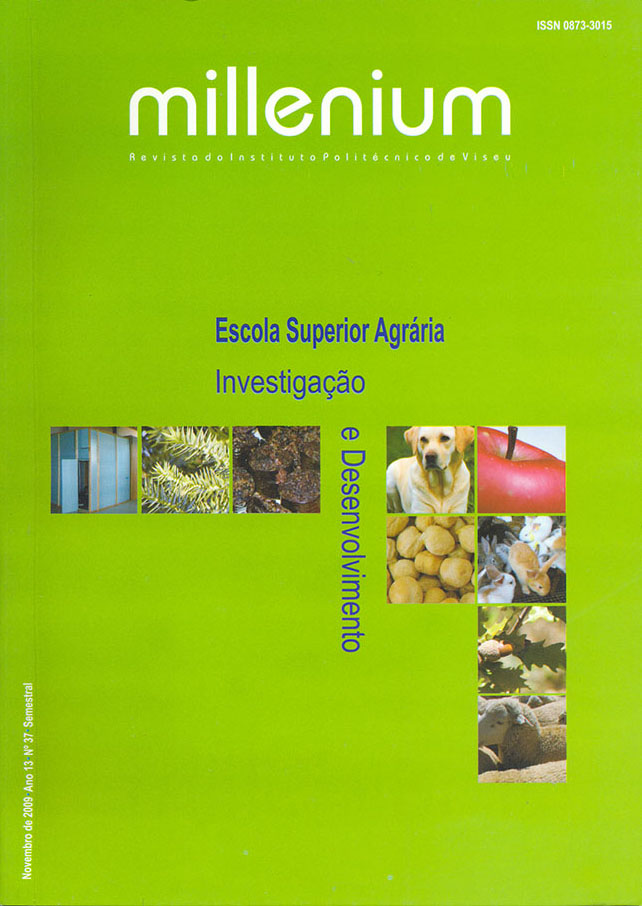Aplicação da econometria espacial às culturas agrícolas permanentes portuguesas
Abstract
A consideração de efeitos espaciais é cada vez mais frequente e para
isso contribuiu, entre outros, o trabalho de Anselin (1988). Neste estudo analisase,
através de métodos de estimação “cross-section”, a influência dos efeitos
espaciais nas culturas agrícolas permanentes das NUTs III de Portugal
Continental, com base nos dados do Recenseamento Geral da Agricultura de
1999, considerando a relação de Verdoorn como base de estudo. Pela análise dos
dados (considerando a estatística Moran´s I) e dos resultados das estimações
(tendo em conta as componentes “spatial lag” e “spatial error”) constata-se que
haverá autocorrelação espacial positiva, sobretudo nos frutos secos e na vinha.
Downloads
References
• ABREU, M.; Groot, H.; and Florax, R. (2004). Spatial Patterns of Technology Diffusion: An Empirical Analysis Using TFP.
ERSA Conference, Porto.
• ANSELIN, L. (1988). Spatial Econometrics: Methods and Models. Kluwer Academic Publishers, Dordrecht, Netherlands.
• ANSELIN, L. (1995). Local Indicators of Spatial Association-LISA. Geographical Analysis, 27, pp: 93-115.
• ANSELIN, L. (2001). Spatial Econometrics. In: Baltagi (eds). A Companion to Theoretical Econometrics. Oxford, Basil
Blackwell.
• ANSELIN, L. (2002a). Spatial Externalities. Working Paper, Sal, Agecon, Uiuc.
• ANSELIN, L. (2002b). Properties of Tests for Spatial Error Components. Working Paper, Sal, Agecon, Uiuc.
• ANSELIN, L. (2002c). Spatial Externalities, Spatial Multipliers and Spatial Econometrics. Working Paper, Sal, Agecon, Uiuc.
• ANSELIN, L. (2002d). Under the Hood. Issues in the Specification and Interpretation of Spatial Regression Models. Working
Paper, Sal, Agecon, Uiuc.
• ANSELIN, L. (2003a). An Introduction to Spatial Autocorrelation Analysis with GeoDa. Sal, Agecon, Uiuc.
• ANSELIN, L. (2003b). GeoDaTM 0.9 User’s Guide. Sal, Agecon, Uiuc.
• ANSELIN, L. (2004). GeoDaTM 0.9.5-i Release Notes. Sal, Agecon, Uiuc.
• ANSELIN, L.; Bera A.K.; Florax, R.; and Yoon, M.J. (1996). Simple Diagnostic Tests for Spatial Dependence. Regional Science
and Urban Economics, 26, pp: 77-104.
• ANSELIN, L. and Bera, A. (1998). Spatial Dependence in Linear Regression Models with an Introduction to Spatial
Econometrics. In: A. Ullah and D. Giles (eds), Handbook of Applied Economic Statistics, New York: Marcel Dekker.
• ANSELIN, L.; Bongiovanni, R.; and Lowenberg-DeBoer, J. (2001). A Spatial Econometric Approach to the Economics of Site-
Specific Nitrogen Management in Corn Production. Working Paper, Sal, Agecon, Uiuc.
• ARBIA, G. and Piras, G. (2004). Convergence in per-capita GDP across European regions using panel data models extended to
spatial autocorrelation effects. ERSA Conference, Porto.
• ARMSTRONG, H. (1995). Convergence Among Regions of the European Union, 1950-1990. Papers in Regional Science: The
Journal of the RSAI, Vol. 74,2, pp. 143-152.
• BALTAGI, B.H.; Song, S.H.; and Koh, W. (2003). Testing panel data regression models with spatial error correlation. Journal of
Econometrics, 117, pp: 123-150.
• BARRO, R. and Sala-i-Martin, X. (1991). Convergence across states and regions. Brooking Papers on Economic Activity, 1, pp:
-107.
• BERA, A. and Yoon, M. (1993). Specification testing with locally misspecified alternatives. Econometric Theory, 9, pp: 649-658.
• BERNAT, Jr., G.A. (1996). Does manufacturing matter ? A spatial econometric view of Kaldor’s laws. Journal of Regional
Science, Vol. 36, 3, pp. 463-477.
• FINGLETON, B. (1999). Economic geography with spatial econometrics: a “third way” to analyse economic development and
“equilibrium” with application to the EU regions. EUI Working Paper ECO nº 99/21.
• FINGLETON, B. (2001). Equilibrium and Economic Growth: Spatial Econometric Models and Simulations. Journal of Regional
Science, 41, pp: 117-147.
• FINGLETON, B. and McCombie, J.S.L. (1998). Increasing returns and economic growth: some evidence for manufacturing from
the European Union regions. Oxford Economic Papers, 50, pp. 89-105.
• FLORAX, R.J.G.M.; Folmer, H.; and Rey, S.J. (2003). Specification searches in spatial econometrics: the relevance of Hendry´s
methodology. ERSA Conference, Porto.
• HANSON, G. (1998). Market Potential, Increasing Returns, and Geographic concentration. Working Paper, NBER, Cambridge.
• KALDOR, N. (1966). Causes of the Slow Rate of Economics of the UK. An Inaugural Lecture. Cambridge: Cambridge University
Press.
• KALDOR, N. (1967). Strategic factors in economic development. Cornell University, Itaca.
• KELEJIAN, H.H. and Robinson, D.P. (1995). Spatial correlation: A suggested alternative to the autoregressive models. In:
Anselin, L. and Florax, R.J. (eds). New Directions in Spatial Econometrics. Springer-Verlag, Berlin.
• KIM, C.W. ; Phipps, T.T. ; and Anselin, L. (2001). Measuring the Benefits of Air Quality Improvement: A Spatial Hedonic
Approach. Working Paper, Sal, Agecon, Uiuc.
• LONGHI, S. ; Nijkamp, P ; and Poot, J. (2004). Spatial Heterogeneity and the Wage Curve Revisited. ERSA Conference, Porto.
• LUNDBERG, J. (2004). Using Spatial Econometrics to Analyze Local Growth in Sweden. ERSA Conference, Porto.
• MESSNER, S.F. and Anselin L. (2002). Spatial Analyses of Homicide with Areal data. Working Paper, Sal, Agecon, Uiuc.
• PAELINCK, J.H.P. (2000). On aggregation in spatial econometric modelling. Journal of Geographical Systems, 2, pp: 157-165.
• SANDBERG, K. (2004). Growth of GRP in Chinese Provinces : A Test for Spatial Spillovers. ERSA Conference, Porto.
• VERDOORN, P.J. (1949). Fattori che Regolano lo Sviluppo Della Produttivita del Lavoro. L´Industria, 1, pp: 3-10.
Downloads
Published
How to Cite
Issue
Section
License
Authors who submit proposals for this journal agree to the following terms:
a) Articles are published under the Licença Creative Commons (CC BY 4.0), in full open-access, without any cost or fees of any kind to the author or the reader;
b) The authors retain copyright and grant the journal right of first publication, allowing the free sharing of work, provided it is correctly attributed the authorship and initial publication in this journal;
c) The authors are permitted to take on additional contracts separately for non-exclusive distribution of the version of the work published in this journal (eg, post it to an institutional repository or as a book), with an acknowledgment of its initial publication in this journal;
d) Authors are permitted and encouraged to publish and distribute their work online (eg, in institutional repositories or on their website) as it can lead to productive exchanges, as well as increase the impact and citation of published work
Documents required for submission
Article template (Editable format)





